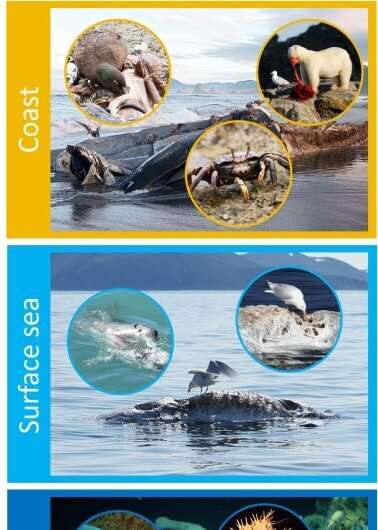Credit: DOI: 10.1016/j.ecoser.2022.101406
The environmental benefits of stranded whale and dolphin carcasses are being undermined by coastal regulations which require remains to be quickly disposed of, a new study has found.
Researchers from the University of Stirling studied the benefits these carcasses bring, and how they are managed by different authorities around the world. They found that, in most places, the environmental benefits are being overlooked.
Dr. Martina Quaggiotto, Lecturer in Ecology in Biological and Environmental Sciences, led the research at the University of Stirling. She said: "Forty percent of the human population—more than three billion people—now live in coastal areas, putting considerable environmental pressure on the other organisms that live in these areas.
"Decomposing whale, dolphin and porpoise—collectively known as cetacean—carcasses provide important nutrients to scavengers such as crabs, seabirds and even polar bears. In South America, the reduction in carcasses has changed the behavior of condors, large birds from the vulture family, who rely on them for food.
"They also increase the nutrients in the soil and sediment where they lie."
Dr. Quaggiotto worked with the Universities of Granada and Glasgow, as well as other international institutions, on the research.
Costs of carcass removal
The study revealed that most coastal areas are currently subject to restrictive regulations that oblige authorities to quickly dispose of cetacean carcasses, which prevents them playing their "complex and indispensable" ecological role.
Dr. Quaggiotto said: "Carcass removal is intended to avoid discontent amongst local communities and tourists, due to the odor, for example. Except, for the most remote and unpopulated coasts where natural decomposition is still allowed, the most frequent disposal practices consist of their burial, incineration and transport to landfills. However, these practices have their own costs, either technical, social, economic, or environmental.
"We recommend revaluating these practices to make them more environmentally friendly, and to consider in each case whether moving the carcass to a more remote beach, closing a section of the beach for a short time or dividing them up for quick decomposition, would be preferable. Scavengers can strip the carcasses surprisingly quickly if left to their own devices."
The study found that in Belgium and France, for example, where there are high densities of strandings, the carcasses were routinely transported to appropriate facilities to be destroyed, compared to New Zealand and the U.S. where most carcasses are left in place. In the UK, as in many other countries, what happens depends on the local authority.
Strandings: A gift from nature
The researchers carried out a literature review and found that our current treatment of these carcasses is at odds with how we thought about them in the past. In the 11th century, for example, cetaceans stranded on English shores were known as "Royal Fish," with the oil used as fuel for lamps, and the bones for tools and in works of art. The Fuegians, from the southernmost Patagonian coast, considered stranded cetaceans a "great gift of nature," and Australian Aborigines believed that strandings could connect them to ancestral lands and seas.
Dr. Marcos Moleón Paiz, who led the research for the University of Granada, said: "Scientists know that humans cannot survive in isolation from nature, and we should be asking ourselves if we want to live in these increasingly aseptic societies. Nature-human connection, rather than disassociation, may be the source of multiple benefits to us and future generations."
The paper, "Past, present and future of the ecosystem services provided by cetacean carcasses" is published in the journal Ecosystem Services.
More information: M.-Martina Quaggiotto et al, Past, present and future of the ecosystem services provided by cetacean carcasses, Ecosystem Services (2022). DOI: 10.1016/j.ecoser.2022.101406. www.sciencedirect.com/science/ … ii/S221204162200002X
Provided by University of Stirling
























